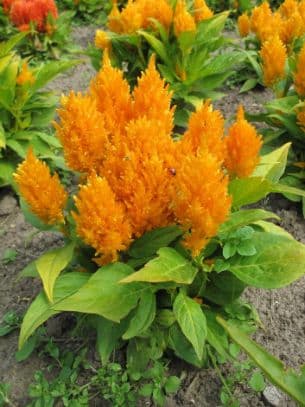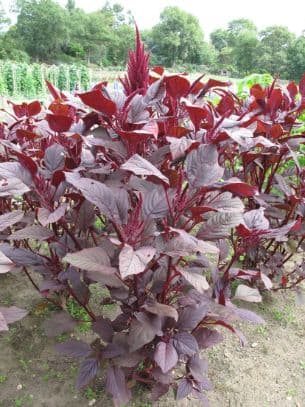Quail Grass 'Kimono Yellow' Celosia argentea var. cristata (Plumosa Group) 'Kimono Yellow' (Kimono Series)

ABOUT
'Kimono Yellow' is a bushy annual with plume-like spikes bearing yellow flowers from summer until early autumn
About this plant
 Names
NamesFamily
Amaranthaceae
Synonyms
Yellow Cock's Comb, Yellow Plume Celosia, Crested Cockscomb, Yellow Woolflower
Common names
Celosia argentea var. cristata
 Characteristics
CharacteristicsLife cycle
Annuals
Foliage type
Deciduous
Color of leaves
Green
Flower color
Yellow
Height
1 feet [0.3 meters]
Spread
1 feet [0.3 meters]
Plant type
Herb
Hardiness zones
2
Native area
Africa
Benefits
 General Benefits
General Benefits- Ornamental Appeal: Its vibrant yellow plumes add aesthetic beauty and a pop of color to gardens and landscapes.
- Low Maintenance: Requires minimal care once established, making it suitable for gardeners of all skill levels.
- Drought Tolerance: Can withstand dry conditions, reducing the need for frequent watering.
- Heat Resistance: Thrives in hot climates, maintaining its visual appeal even during the height of summer.
- Annual Growth: Completes its life cycle in one season, allowing for rotation with other plants each year.
- Edging and Border Plant: Its compact size and unique texture make it ideal for use in garden borders and edges.
- Container Gardening: Suitable for growing in pots, making it a versatile choice for balconies and patios.
- Attracts Pollinators: Invites beneficial insects, such as bees and butterflies, contributing to the health of the garden ecosystem.
- Easy to Propagate: Can be easily propagated from seeds, making it cost-effective and simple to expand your garden.
 Medical Properties
Medical Properties- This plant is not used for medical purposes.
 Air-purifying Qualities
Air-purifying QualitiesThis plant is not specifically known for air purifying qualities.
 Other Uses
Other Uses- Crafts: The vibrant flowers of the Celosia can be dried and used in creating decorative wreaths or arrangements for a pop of color that lasts long after the growing season.
- Garden Border Accent: With its unique feathered flowers, this variety of Celosia makes a stunning accent in garden borders, adding contrast against other green foliage.
- Fabric Dye: The bright pigments of the 'Kimono Yellow' flowers can be used to create a natural dye for coloring textiles.
- Photography Prop: Its distinctive appearance makes the Celosia a sought-after subject for garden photographers and influencers looking for an eye-catching plant to feature.
- Edible Garnish: Although not commonly consumed in many cultures, the Celosia's flowers can be used as an ornamental and edible garnish in exotic cuisine.
- Teaching Tool: Schools and educational programs can utilize this cultivar to teach children about plant biology and the diversity of plant life.
- Livestock Fodder: In some regions, the Celosia plant is used as fodder for animals due to its quick growing nature and nutritional content.
- Artistic Inspiration: Artists can take inspiration from the Celosia's form and color, using it as a subject in paintings and other art forms.
- Feng Shui: Some practitioners of Feng Shui might use Celosia plants to add the fire element into a space due to their flame-like appearance and vibrant color.
- Potpourri Ingredient: Dried Celosia flowers can be included in homemade potpourri mixtures to add color and a gentle, natural fragrance to a room.
Interesting Facts
 Feng Shui
Feng ShuiCelosia is not used in Feng Shui practice.
 Zodiac Sign Compitability
Zodiac Sign CompitabilityCelosia is not used in astrology practice.
 Plant Symbolism
Plant Symbolism- Immortality: The name 'Celosia' comes from the Greek word 'kelos,' meaning burned; it represents enduring spirit and the immortality of the soul due to its flame-like flower form.
- Affection: In the Victorian language of flowers, celosia is associated with affection and warmth of the heart because of its vibrant and fuzzy appearance, which is supposed to evoke feelings of love and passion.
- Boldness: The vivid colors and unique shapes of the crested celosia embody boldness and courage, encouraging individuals to stand out and be audacious in their pursuits.
- Good Fortune: In some cultures, celosia is believed to bring good luck and is therefore often used in festivities and celebrations as a harbinger of prosperity and good fortune.
 Water
WaterCockscombs, like the 'Kimono Yellow', prefer consistent moisture in well-draining soil. During the growing season, water them thoroughly once the top inch of soil feels dry. This might translate to watering once every 7 to 10 days, depending on the climate and weather conditions. Each watering should be deep enough to moisten the soil without waterlogging it, which might mean about 1 to 2 gallons, depending on the size of the plant and the pot. Reduce watering frequency in the cooler months to prevent root rot.
 Light
LightCockscombs require full sun to flourish, meaning they need at least 6 to 8 hours of direct sunlight daily. Place the 'Kimono Yellow' in a location that receives unfiltered sunlight for the majority of the day. An east or west-facing window can be ideal for indoor growing, while an open spot in the garden suits outdoor growth.
 Temperature
TemperatureCockscombs thrive in warm conditions and should be kept in temperatures ranging from 60 to 80 degrees Fahrenheit. They are not cold-hardy and may not survive temperatures below 50 degrees Fahrenheit. The ideal temperature range for vigorous growth and flowering of 'Kimono Yellow' is between 70 and 75 degrees Fahrenheit.
 Pruning
PruningPruning cockscombs encourages bushier growth and more blooms. For 'Kimono Yellow', deadhead spent flowers to promote continued blooming. Trim back any leggy or overgrown stems during the growing season to maintain a neat shape. The best time for pruning is late spring or early summer when the plant starts to put out new growth.
 Cleaning
CleaningAs needed
 Soil
SoilFor the Cockscomb 'Kimono Yellow', the best soil mix is well-draining with a mix of regular potting soil, peat moss, and perlite or sand. The ideal pH for this plant is slightly acidic to neutral, ranging from 6.1 to 7.5.
 Repotting
RepottingCockscomb 'Kimono Yellow' should be repotted every 1-2 years in the spring, before the onset of the growth season, to ensure it has enough space and nutrients to grow.
 Humidity & Misting
Humidity & MistingCockscomb 'Kimono Yellow' thrives in moderate to high humidity levels, ideally around 40-60%, but can tolerate lower humidity environments as well.
 Suitable locations
Suitable locationsIndoor
Place in bright, indirect light and keep soil moist.
Outdoor
Full sun, well-drained soil, moderate water.
Hardiness zone
10-11 USDA
 Life cycle
Life cycleCelosia argentea var. cristata (Plumosa Group) 'Kimono Yellow', commonly known as the Cockscomb, begins its life as a seed typically sown indoors in late winter to early spring. Germination occurs within 1-2 weeks in warm conditions, after which the seedling develops true leaves and is eventually transplanted outdoors following the last frost when soil temperatures are warm. The vegetative stage of growth involves the plant producing a rosette of leaves and elongating its stem. During the flowering stage in summer and early fall, the Cockscomb produces vibrant yellow, feathery plumes that are prized for their ornamental value. After pollination, seeds develop that will be dispersed or collected once the plant senesces at the end of the growing season. These seeds can remain dormant over the winter until suitable conditions for germination return in the following spring.
 Propogation
PropogationPropogation time
Spring to Summer
Celosia argentea var. cristata, commonly known as crested cockscomb, is most popularly propagated through its seeds. The best time to sow cockscomb seeds is in the spring after the last frost when the soil has warmed up to at least 60°F (15.6°C). Seeds should be surface sown on well-drained soil and lightly pressed in or covered with a thin layer of soil no more than one-eighth of an inch deep. They require consistent moisture to germinate, which typically occurs within 7 to 14 days. Once the seedlings develop true leaves, they can be thinned and eventually transplanted outdoors, maintaining a space of about 8 to 12 inches (20 to 30 cm) between plants to ensure ample airflow and prevent mildew issues as the plants mature.




